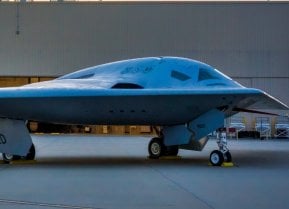5 Reasons The Iowa-Class Were the Best Battleships Ever
The Iowa-Class was built for punishing battle, and, accordingly, she was heavily armored. The Iowa was built with the “all-or-nothing” armor scheme.
The Iowa-class battleships were the last ever commissioned in the US Navy, and in the opinion of many, the best battleships ever commissioned.
Originally intended to intercept fast Japanese chips like the Kongo-class, the Iowa could also join a traditional battle line, adding immense firepower.
Serving admirably for nearly fifty years on and off out of various states of retirement, the Iowa-Class contributed to US efforts in four wars, ultimately retiring as one of the most storied classes in US naval history.
Iowa-Class: The Best Battleships Ever
Let’s consider the five attributes that made the Iowa-Class so unique and the best battleships ever to set sail.
One, Size and Power for the Iowa-Class
The Iowa-class battleship was 860 feet long at the waterline with a beam of 108 feet and a draft of 37 feet.
Iowa’s total displacement was 58,460 tons after being designed with the “elevator clause” of the Second Lond Naval Treaty” in mind (which initially capped battleship displacement at 45,700 tons but was eventually adjusted to accommodate Japan’s succession from the treaty).
Two, Firepower
The simple fact is that the Iowa-class is the most heavily armed warship that the US Navy has ever sailed.
Despite first being laid down in 1940, to combat the Japanese threat, the Iowa’s weapons systems were continuously updated and upgraded throughout the boat’s fifty years of service.
The primary armament of the Iowa class was nine breech-loading 16-inch (406mm)/50-caliber Mark 7 naval guns. The Mark 7 guns were housed in three 3-gun turrets, which were configured with turrets forward and one turret aft (the “2-A-1” configuration).
The Mark 7 guns were each 66 feet long, which is 50 times longer than their 16-inch bore. Of the Mark 7’s 66 foot length, only 43 feet protruded from the gun house. Each gun weighed about 239,000 pounds and fired 2,700 pound armor-piercing projectiles at a muzzle velocity of 2,500 feet per second at a range of 24 miles. Put simply, the Iowa’s Mark 7 guns were massive.
Complementing the Mark 7’s were twenty 5-inch (127mm)/38 caliber Mark 12 guns. The Mark 12 guns were enclosed within ten Mark 28 Mod 2 base ring mounts. The Mark 12 had originally been installed on American destroyers built during the 1930s – but the gun proved so successful that it was eventually added to all warships built between 1934 and 1945.
The Mark 12 was considered “highly reliable, robust and accurate,” according to the Navy’s Bureau of Ordnance.
The Mark 12 weighed nearly 4,000 pounds with a bore length of 190 inches and a rifling length of 157 inches. The Mark 12 fired shells at about 2,500 feet per second.
The Mark 12 was known as a dual-purpose gun (DP), meaning that it could fire at both surface and air targets. While initially conceived as a surface-targeting weapon, the Mark 12 proved effective at shooting down Japanese aircraft – especially once the gun was upgraded with a Mark 37 Fire Control System, a Mark 1A computer, and proximity-fused shells.
Three, Speed
The Iowa-Class was large – and heavily armed – yet she could still move.
The boat featured eight Babcock & Wilcox boilers and four double reduction cross-compound geared turbines; each turbine drove a single shaft.
The powerplant produced 212,000 horsepower and propelled the nearly 900-foot battleship at 32 knots per hour. To operate the powerplant, the Iowa carried nearly 9,000 tons of fuel – good for a range of 18,300 miles).

To help harness Iowa’s impressive propulsion system, the ship relied on two semi-balanced rudders, which gave the ship a tactical turning diameter of 814 yards at 30 knots.
Four, Armor of the Iowa-Class
The Iowa-Class was built for punishing battle, and, accordingly, she was heavily armored. The Iowa was built with the “all-or-nothing” armor scheme. In the all or nothing scheme, the areas that are most important to the ship are heavily armored, whereas the less important areas receive no armor whatsoever. The all-or-nothing scheme avoided the use of thin armor anywhere. Instead, wherever armor was installed, that armor was used in the most practicable thickness. The result was either “total or negligible protection.”
The Iowa’s all-or-nothing layout, in theory, granted the boat a zone of immunity against fire from 16-inch/45-caliber guns between 18,000 and 30,000 yards. The specific armor used on the Iowa included Class A face-hardened Krupp cemented armor and Class B homogeneous Krupp-type armor. Also, the Iowa incorporated special treatment steel (STS) extensively throughout the hull (STS is comparable to Class B armor).
Five, Longevity
The Iowa are celebrated not just for their design but for their service history. While the boat was designed to face the Japanese threat in the Pacific, the Iowa endured, serving in the Korean War, the Vietnam War, and remarkably, in Operation Desert Storm.
So, the Iowa battleships fired upon Hirohito’s Japan and Saddam’s Iraq.
The Iowa’s are still serving today – in a sense; all four are preserved as museum ships, in New Jersey, Virginia, California, and Hawaii – where the general public can visit and appreciate firsthand what made the Iowa so formidable.
About the Author
Harrison Kass is a defense and national security writer with over 1,000 total pieces on issues involving global affairs. An attorney, pilot, guitarist, and minor pro hockey player, Harrison joined the US Air Force as a Pilot Trainee but was medically discharged. Harrison holds a BA from Lake Forest College, a JD from the University of Oregon, and an MA from New York University. Harrison listens to Dokken.


